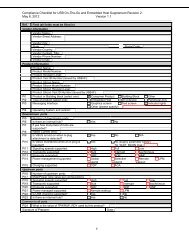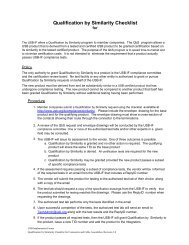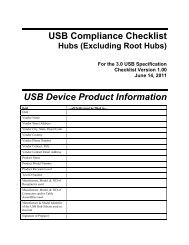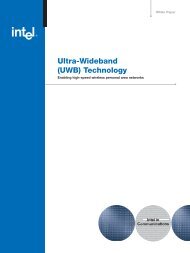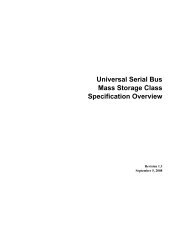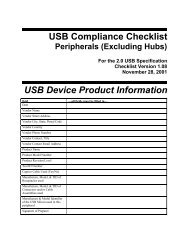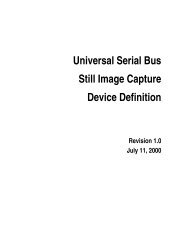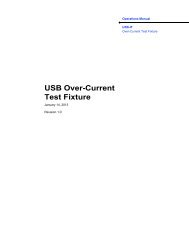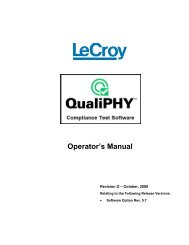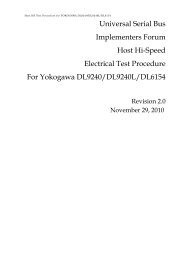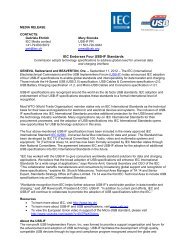Create successful ePaper yourself
Turn your PDF publications into a flip-book with our unique Google optimized e-Paper software.
62 <strong>HID</strong> <strong>Sensor</strong> <strong>Usage</strong>s<br />
Set Feature Reports are sent from the host to the device. They are used to set configuration Properties into<br />
a sensor by invoking the <strong>HID</strong> SET FEATURE REPORT. This might include the desired sample rate and<br />
reporting preferences. <strong>Sensor</strong> Properties are equated to <strong>HID</strong> Feature Report Items.<br />
3.6.1 <strong>HID</strong> Report Item packing options<br />
Items come in varying sizes, depending upon their data types, and whether they are a scalar or an array.<br />
This is specified by the Report Size and Report Count values in the Report Descriptor.<br />
Examples for common data types (non-exhaustive list):<br />
Conventional Data Type <strong>HID</strong> Report Size (bits) <strong>HID</strong> Report Count<br />
boolean 1 1 1<br />
unsigned char 8 1<br />
char 8 1<br />
unsigned short 16 1<br />
short 16 1<br />
unsigned long 32 1<br />
long 32 1<br />
unsigned long long 64 1<br />
long long 64 1<br />
float 2 32 1<br />
double 64 1<br />
String; char[n] 8 n<br />
Wide String; wchar_t[n] 16 n<br />
Array of long; long[n] 32 n<br />
Table 8. Common Data Types expressed as Report Size and Report Count<br />
One strategy is to pack as many Items into a Report as will fit in the available space. Another strategy is to<br />
only put a single Item in each Report. The following are examples of each of these strategies.<br />
Byte<br />
Bit Position in the byte<br />
Position 7 6 5 4 3 2 1 0<br />
0<br />
1<br />
Report ID = 0x01<br />
2<br />
3<br />
4<br />
Data Field = 0x12345678<br />
Table 9. Input Report with a single scalar Data Field of Report Size 32, Report Count 1<br />
Byte<br />
Bit Position in the byte<br />
Position 7 6 5 4 3 2 1 0<br />
0 Report ID = 0x23<br />
1<br />
2<br />
Data Field 1 = 0xFF00<br />
1<br />
For ease of programming, it is customary to byte-align Boolean values in <strong>HID</strong> reports. For example, if 3<br />
Boolean bits are needed, they are followed by 5 unused “padding” bits so that the total fills up to an even<br />
byte boundary.<br />
2<br />
<strong>HID</strong> has a special technique for representing floating point numbers, which is described in Section 4.2.1<br />
Values, Types, and Unit Exponents below.



